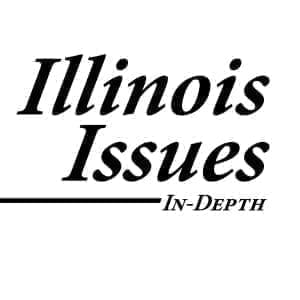Illinois Issues: Is The State Budget Balanced?

By including money from selling bonds and paying down Medicaid debt, Illinois could see a surplus this fiscal year, according to a report from Gov. Bruce Rauner's office. TaxCredits.net/https://creativecommons.org/licenses/by/2.0/
Commentary: Gov. Bruce Rauner recently criticized the Democrats for passing a spending plan that is more than a billion dollars out of balance, according to analysis from his budget office. That same report noted that if one-time revenues are included, the state could see a surplus at the end of the year.
The legislature’s majority Democrats projected that revenues would exceed expenses by $360 million when Fiscal Year 2018 ends next June 30, under their spending plan and accompanying tax hikes approved over Gov. Bruce Rauner’s vetoes in early July.
In response, the Republican governor and his budget aides argue that the Democratic budget was some $1.7 billion out of balance, even after the 32 percent increase in income tax rates, a charge documented in a report issued a couple of weeks ago.
Who’s right?
Turns out, both camps are, if one takes into account the timing and the underlying assumptions behind some of the numbers.
First, the timing.

Charles N. Wheeler III is the director of the Public Affairs Reporting Program at the University of Illinois Springfield.
When Democrats crafted their budget in late spring, all sides expected a stronger revenue performance in FY ’17 than the actual receipts showed at year’s end. The legislature’s fiscal arm, the Commission on Government Forecasting and Accountability, expected receipts of $30.2 billion in general funds, the state checking account which pays most day-to-day operations and underwrites costly programs like education and health care. The projection from the Governor’s Office of Management and Budget (GOMB) was even higher, with a general funds estimate of $30.7 billion.
When the curtain closed on FY ’17 on June 30, however, general funds receipts were only $29.4 billion, some $800 million less than legislative expectations and $1.3 billion below the governor’s prediction.
Because the starting point for the next year’s projected revenue is the current year’s actual receipts, the initial 2018 estimates by both camps now are considered too high after taking into account the $5.5 billion in new tax receipts. The governor’s current general funds estimate is $35.9 billion, according to the October report, some $500 million less than lawmakers counted on in drafting their plan using the earlier revenue estimate.
So, one might conclude three extra months helps to bring the future in clearer focus in one’s crystal ball.
Next, the assumptions.
Legislative budget-makers arrived at their $360 million surplus in part by cutting pension spending by $1.5 billion to reflect FY ’18 savings they expected from changes, most notably a new Tier 3 retirement option for state workers and public school teachers outside Chicago that combines a reduced defined benefit with a 401(k) style defined contribution.
Rauner’s February budget proposal also counted on saving $1.2 billion from similar changes, but pension administrators now say they don’t believe the Tier 3 changes can be implemented before next summer, costing almost $600 million in anticipated FY’18 savings.

Money from the proposed sale of Chicago's Thompson Center is included in the FY '18 budget. But the proposal, which Gov. Bruce Rauner suggested in 2015, hasn't made it out of the General Assembly.
In addition, the legislative plan counted a $300 million boost to the general funds from sale of the Thompson Center in Chicago’s Loop. Whether the sale actually will happen this fiscal year is debatable, and in any event, the state is likely to realize only about $240 million after expenses, according to a Civic Federation analysis.
Finally, a major reason for the contradictory reviews is simply the result of counting things in different ways.
For example, the legislative plan includes authority to borrow up to $6 billion to help pay past due bills, a backlog standing at $16.3 billion as of October 20, according to the comptroller. But Rauner’s aides say lawmakers failed to set aside the costs of debt service — principal and interest payments — for the $6 billion in bonds, a shortfall they pegged at $535 million. At the same time, the governor’s analysis doesn’t include any proceeds from the bond sales in arriving at its conclusion that spending will outstrip revenues in FY ’18.
That’s the message that Rauner and his fellow Republicans want voters to hear, of course: another unbalanced budget from legislative Democrats, with the added note that it’s all House Speaker Michael Madigan’s fault.
Campaign rhetoric aside, however, the GOMB “Illinois Economic and Fiscal Report” itself presents a more complete picture of FY ’18 finances in its financial walk down chart.
After the governor sliced some $200 million in program spending, the gap between estimated revenues and estimated spending now stands at a $1.5 billion deficit, according to the report. But including one-time revenues such as the borrowing produces a different picture.
The report notes that a huge chunk of the bond proceeds will be used to pay outstanding claims for Medicaid, the joint state-federal health insurance program for lower-income families, persons with disabilities and senior citizens. The increased state Medicaid spending will bring in an estimated $1.1 billion as the federal share of program costs, according to the report.

Selling $6 billion in bonds, which the governor began to do this month, to pay down Medicaid bills will bring in more revenue through federal reimbursements, according to a budget report from the governor's office.
In addition, the legislature’s budget package included provisions to shift money from some of the state’s 700-plus other funds into the general funds account, which Rauner’s aides figure will add some $850 million to the bottom line.
The result? An adjusted general funds surplus of some $2.2 billion for FY ’18, quite a contradiction to the governor’s story line.
But don’t break out the champagne yet. The report also looks ahead to FY ’19 and beyond, when no more borrowing to pay old Medicaid bills and thus no more federal windfalls are part of the equation. The results are ongoing deficits in the $1.5 billion range for the next three years.
Thus, the real challenge for the governor and for lawmakers will come next spring, when it’s time to fashion a budget for FY ’19 with a projected $1.5 billion deficit looming.
Will anyone want to raise taxes again? Or chop $1.5 billion from education, health care or human services, which together account for more than 85 percent of general funds spending?
Might there be some interest in a relatively painless way to make ends meet, short of higher taxes and/or deeper cuts? If so, the governor and lawmakers might want to consider two possibilities that would rely on citizens choosing to pay more into state coffers of their own free will.
The first is hardly a new idea. Talk of expanding gambling in the state has gone on for years, most recently leading to legalization of video gaming, signed by former Gov. Pat Quinn in 2009. But Quinn also vetoed plans to add riverboats and other gaming options, and proponents have continued their campaign.

Gambling expansion has long been a suggestion for raising revenue in Illinois. Charles Wheeler writes it could again be on the table to balance next year's budget.
Last spring, the Senate approved an ambitious plan to create a land-based Chicago casino; authorize five new riverboats in the south suburbs, Lake County, Rockford, Danville and southern Illinois; allow the 10 existing riverboats to add more slot machines and table games, and permit slot machines at horse racing tracks. The legislation stalled in the House, but could be revived as part of a budget deal next spring.
As drafted, the proposal probably would generate less than $100 million in additional annual revenues, according to an analysis by the legislative commission. But advocates point out the initial bidding process for the new licenses would produce a significant amount of one-time revenue, perhaps as much as $1 billion, no small amount given the state’s needs.
Another possible moneymaker for the state, but more controversial than gambling expansion, would be legalization of recreational marijuana use. Measures are pending in both the Senate and the House to allow adults to grow and smoke pot under tightly-regulated conditions, which one national advocacy group predicted could provide Illinois as much as $700 million in new money annually.
While legalizing and taxing marijuana wouldn’t solve all the state’s fiscal woes, noted sponsoring Sen. Heather Steans, a Chicago Democrat, “it should be a part of the conversation about resolving Illinois’ worsening budget problems.”
One added benefit could be its role as an effective alternative to opioids for pain management, as the state faces a growing crisis of overdose deaths.

More gambling and legal pot might appear rather unsavory ways to help get Illinois’ fiscal house in order, but the guess here is that plenty of Illinoisans would just as soon let the other guy’s vices, not their wallets, pay the state’s bills.
Illinois Issues is in-depth reporting and analysis that takes you beyond the headlines to provide a deeper understanding of our state. Illinois Issues is produced by NPR Illinois in Springfield.
Links
- Illinois Issues: Cities Lose Out On Retail Tax As Online Shopping Booms
- Illinois Issues: Land of Lincoln, New Jersey Compete For Worst Fiscal Condition
- Illinois Issues: Worry About DACA’s Fate Triggers Anxiety, Depression In Immigrants
- Illinois Issues: Coming Up In The Veto Session
- Illinois Issues: We Have Met The Enemy And He Is Us
- Illinois Issues: A Master Of Compromise Exits
- Illinois Issues: The Man With The Education Reform Mission
- Illinois Issues: No Money For Shoes
- Illinois Issues: Flat Vs. Graduated Income Tax
- Illinois Issues: Cairo Faces Public Housing Crisis
